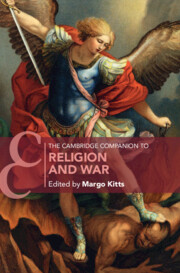Book contents
- The Cambridge Companion to Religion and War
- Cambridge Companions to Religion
- The Cambridge Companion to Religion and War
- Copyright page
- Contents
- Contributors
- Preface
- Introduction
- Part I Classical Foundations
- 1 Biblical Paradigms of War in History and Eschatology
- 2 Early Christianity and War
- 3 Fighting and Martial Valor in Islamic Thought
- 4 Hinduism and War
- 5 Buddha in the Ring of Fire
- 6 Sikhism
- 7 Religion and War in Traditional China
- 8 Buddhism and War in Premodern Japan
- Part II Just War
- Part III Religious Nationalism
- Part IV Featured Conflicts
- Index
- Cambridge Companions to Religion (continued from page ii)
- References
2 - Early Christianity and War
from Part I - Classical Foundations
Published online by Cambridge University Press: 04 May 2023
- The Cambridge Companion to Religion and War
- Cambridge Companions to Religion
- The Cambridge Companion to Religion and War
- Copyright page
- Contents
- Contributors
- Preface
- Introduction
- Part I Classical Foundations
- 1 Biblical Paradigms of War in History and Eschatology
- 2 Early Christianity and War
- 3 Fighting and Martial Valor in Islamic Thought
- 4 Hinduism and War
- 5 Buddha in the Ring of Fire
- 6 Sikhism
- 7 Religion and War in Traditional China
- 8 Buddhism and War in Premodern Japan
- Part II Just War
- Part III Religious Nationalism
- Part IV Featured Conflicts
- Index
- Cambridge Companions to Religion (continued from page ii)
- References
Summary
While many accounts of early Christianity see the early Church as a pacifist movement, closely following Jesus’ non-retaliatory teaching, this chapter argues that there is a more ambiguous relationship to violence in the first three centuries of the Christian movement, including military service. Aside from the violent rhetoric in the eschatological parables of Jesus, Christians appropriated the violence of the Hebrew Bible to shape negative views of outsiders, which in turn prepared the way from actualised violence in the post-Constantine era.
- Type
- Chapter
- Information
- The Cambridge Companion to Religion and War , pp. 52 - 75Publisher: Cambridge University PressPrint publication year: 2023



